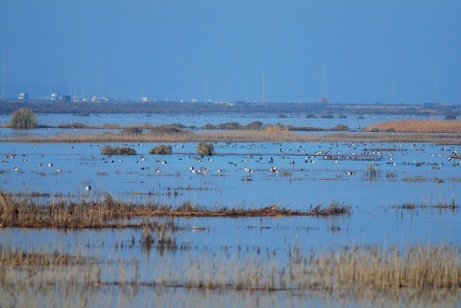by Joe Eaton
Real estate developers often name their projects for what they’ve displaced: Quail Acres, Live Oak Estates. Egret Bay would have been another such necronym. The 4,500-home development proposed for the former Cullinan Ranch on San Pablo Bay in 1983 would have left little room for egrets, or other birds. A citizen’s group, Vallejoans for Cost Efficient Growth, supported by Save the Bay and other environmental organizations, helped kill Egret Bay, and, in a deal brokered by Congresswoman Barbara Boxer, the land became part of the San Pablo Bay National Wildlife Refuge. Then came the process of restoring the badly subsided 1,500 acres to tidal wetland. On January 6, the dike between Cullinan and Dutchman Slough, a tidal arm of the Napa River and San Pablo Bay, was breached in three places, reconnecting the parcel to the Bay for the first time since it was drained and planted in oat hay in the 1880s. The waters rushed in, followed by thousands of canvasback ducks—one of the intended beneficiaries of the refuge—and other waterfowl. “They’re taking advantage of the fact that here, all of a sudden, is a food source,” says Refuge Manager Don Brubaker. “All you have to do is add water. It’s like making oatmeal.”
Early plans for Egret Bay, touted by Walden R. Williams of Huntington Beach and backed by secretive Japanese investors, included 3,000 single-family homes selling for $215,000 (equivalent to half a million today), plus condos and boating facilities. The median sales price of a new home in Solano County in 1983 was $126,000. Besides loss of existing wetlands, concerns included traffic congestion on already dangerous Highway 37, problematic water and sewer connections, and the need for 7 million cubic yards of fill. The city of Vallejo bought the proposal, but biologist Francesca Demgen, Robin Leong of Napa-Solano Audubon, and other activists went to court, with support from Save The Bay. The San Francisco Bay Conservation and Development Commission (BCDC) and California Attorney General John Van De Kamp filed parallel suits. The Environmental Impact Statement for the project was rejected, and the US Army Corps of Engineers denied a key permit because of impact on endangered species and inadequate mitigation. Egret Bay lingered for a few years, but Demgen recalls that Williams eventually went away. Boxer’s support saved the parcel for restoration.
 “It feels fantastic,” says Renee Spenst of Ducks Unlimited, who devoted seven years to the Cullinan restoration. “We finally pushed the boulder up the hill.” (See “Cullinan’s New Crust,” Estuary News, November 2012.) She calls Cullinan “a challenging project, with a lot of plate-spinning going on to keep everything together.” With federal coffers drying up, Spenst helped pull together a network of funding partners to complete the $15 million package. Recreating wetland along three miles of 37 required “delicate negotiations” with CalTrans, and protecting the roadway was complicated by projections of sea level rise.
“It feels fantastic,” says Renee Spenst of Ducks Unlimited, who devoted seven years to the Cullinan restoration. “We finally pushed the boulder up the hill.” (See “Cullinan’s New Crust,” Estuary News, November 2012.) She calls Cullinan “a challenging project, with a lot of plate-spinning going on to keep everything together.” With federal coffers drying up, Spenst helped pull together a network of funding partners to complete the $15 million package. Recreating wetland along three miles of 37 required “delicate negotiations” with CalTrans, and protecting the roadway was complicated by projections of sea level rise.
“The waterfowl response to the breach was almost instantaneous,” recalls Brubaker: up to 4,000 ducks showed up. Ducks Unlimited biologist Craig Garner estimates around 2,000 canvasbacks. During high tides, stilts, avocets, and other shorebirds are using the 16 oblong marsh mounds engineered into the project. Egrets, grebes, and cormorants have also been observed foraging for aquatic prey.
San Francisco Bay is the most important wintering location on the Pacific Flyway for canvasbacks, and most concentrate in San Pablo Bay. Thirty years ago, biologist Warren Reinecker estimated that 80 percent of the flyway’s canvasbacks used San Pablo Bay. Numbers have fluctuated, but there are still lots of these handsome white-backed diving ducks. Brubaker notes that canvasbacks, while recovering from earlier lows, “are still not doing as well as we’d like.” Locally-wintering birds may have nested anywhere from Alaska to Alberta, experiencing the effects of climate change, resource extraction, and agricultural expansion.
As sediment accretes, Cullinan will also become habitat for the endangered Ridgeway’s rail (formerly called the California clapper rail) and salt marsh harvest mouse. Refuge managers hope to jumpstart that process on 290 acres with dredged material from the Mare Island dry docks. “BCDC came to us over a year ago about beneficial reuse,” says Spenst. Brubaker says all the permits are in place and pumping could start any day now, hastening the day when the refuge can start farming mice and rails.
On the day of the breach, Demgen looked back: “Today we are witnessing how wildly successful a handful of committed folks supported by a large group of believers can be!” If Egret Bay had gone through, she says, “the North Bay would have gone down like dominoes.” What could have become Foster City North, an entering wedge for the development of the San Pablo Bay shoreline, is now a key piece in a mosaic of protected tidelands.
CONTACT: Don Brubaker, [email protected]; Francesca Demgen, [email protected]; Renee Spenst, [email protected].
NEXT ARTICLE: Rethinking our Grandest Plan for the Estuary